Folk Games
Folk Games are traditionally played for amusement and entertainment. Folk games are divided into three groups based on the environment in which the games are played: land, water and sky.
Games on land predominate and include games that are played by both boys and girls and those that are played by only one gender.
Ayabga-ayanga (the tiger and the goats) is a group game played by both boys and girls. A large circle is drawn on the ground. One player plays the role of the tiger and remains outside the circle, while the other players play goats and stay inside it. The player outside recites set rhymes and goes round the circle, trying to catch the players inside off guard. One such rhyme used in the game in the Jessore region is as follows: 'Tiger: Weep, weep! Goats (in chorus): What are you crying for? Tiger: Lost a cow. Goats: What sort of cow? Tiger: A red one. Goats: Does it have horns? Tiger: Yes. Goats; Sing a song. The tiger then starts dancing and singing: Who took my cow? Who took my cow? Come here, you who took my cow. Suddenly he stops short and jumps forward to drag one of the players outside the circle. The other players hold him back so that the tiger cannot take the goat away. The goats taken out of the circle by the tiger belong to the tiger's side. The last player in the circle becomes the tiger in the next round.
Baghbandi (capturing the tiger) a checkers-like game, played on a board outlined on the ground. The board has 16 squares. Twenty pieces, known as bakri (goats), are placed in groups of five at four places on the board. Two bigger pieces, known as bagh (tiger), are placed elsewhere. Two players, one taking the side of the tiger and the other taking that of the goats, start moving their pieces. The goats try to block the passage of the tiger, by not giving it two vacant positions in a row so that it cannot advance or jump over. If the tiger jumps over a goat to the next vacant position, the goat dies and is removed from the board. If the tiger kills all the goats, the player with the tiger becomes the winner. If the goats can block the passage of the tiger, the player with goats becomes the winner.
Bauchhi (the old lady) This game requires two courts outlined on the ground, one rectangular and the other circular, twenty-five to thirty feet apart from each other. Two teams of eight to ten players are needed for this game. One player of the team winning the toss plays the budi (old lady) and remains inside the circle. The remaining members of the team stay inside the rectangular court.
The object of the game is for the player of the opposing team to take the 'old lady' to the rectangle, without being touched. If he is able to take the 'old lady' to the rectangle, the team earns a point and the players he touches become out. Variations of the game are known as budikapati, bau-basanti budir chu etc.
Chikka (tug and trip) This game of physical endurance is played by two teams consisting of five to seven players. The two teams line up facing each other across a line drawn on the ground. One player challenges one of the opposing players by stretching his hands towards him, in what is known as 'giving hetel (the handle)'. The other player catches hold of his hands and they start pushing or pulling in a bid to trip each other. The one who budges from his position is considered out. If a team can trip all its opponents, it earns points and starts the next round. Players also try to trip their opponents with their legs. If a team can trip all the players of the opposing team, it earns points and retains the round. The process is repeated by turns.
Chhadar Khela (rhyming game) a counting rhyme game, it is played by boys and girls. The players sit on the ground, holding their hands open flat. The leader also holds out one of his/her hands and, touching each hand on the ground, utters the rhyme: ikdi mikdi cham chikdi/ chamer beta laksindar/ seje ela damodar. Everybody waits for the last word to be uttered. The player who is touched with the last word closes his/her hand. The game continues till the last hand is closed.

Chhi-chhattar (the kite and the cocks) Ten to fifteen boys form a circle, holding each other's hands. One player stands in the middle of the circle. In the rangpur areas, the child in the middle is called a 'kite', and the others 'cocks'. The kite tries to break free from the ring formed by the cocks. He frets and struts and recites the rhyme: chhi chhai ghoda dabai/ ghoda na ghudi, chabuk chhudi/ chabuk diya marlam badi/ dhula uthe kari kari (What a horse I ride! Is it a horse or a mare? When I smack it with a whip, it only raises row of dust). The player then runs out, breaking the circle at a point where someone is off-guard. The cocks then run after him, and the one who catches him plays the kite in the next round. The cocks also recite a rhyme: Chhi chhattar kachur bai/ chyabgda pyangdar nana hai/ taker upar ayna/ punti machh khay na/ taker upar gosta/ chhonya dile dosta (What is this? I'm respected as grandpa by children. My bald head shines like a mirror. I don't eat tiny fish. If someone can touch my head, I become his friend). A variation of this game is played in the Himalayan region where it is known as chilla-daoma.
Chungakhela (the crackers game) an adult game, played mainly in chittagong, on the eve of shab-e-barat. The opposing teams try to hit their opponents with crackers. Sometimes the crackers cause burn injuries. The game is spectacular, with sparks and flashes of crackers, coupled with deafening sounds, amid cheers from the spectators. Starting from sunset, the game continues till midnight. This expensive and dangerous game is now almost extinct.
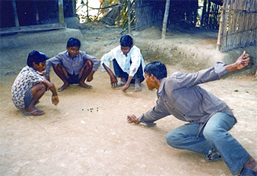
Danguli (tipcat) a favourite boys' game played by two teams of five to six players. A two-foot long stick, known as danda, and a five- to six- inch stick, known as guli or phutti, are used to play the game. There is a similar game in Europe called tipcat, where the longer stick is used to tip the 'cat', the smaller one.
The object of the game is for one side to strike the guli with the danda. The other side has to catch the guli before it falls. If the guli is caught, the player who has struck it is out. If the guli isn’t caught, he continues till he is out. If he is out, the next player in the team comes in. One team plays after the other. The game is also known as dangbadi, gutbadi, tyamdang, bhyatadanda etc.
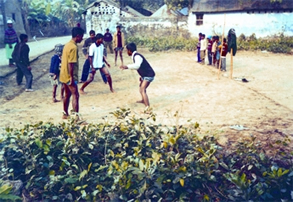
Dariyabanda (stealing the salt) This is a popular competitive game, played by two teams composed of five to seven players each on a square outlined on the ground. A number of small squares are drawn inside the big one, depending on the number of players. One of the squares is called gadighar (team's chamber) and the other is called labanghar (salt chamber). At the start of the game, the members of one team stay inside the gadighar while their opponents stand in a way that no one can pass from one square into another. A member of the team darts forth or dodges past the players on guard and tries to cross all the cells and return to the gadighar. If one of the members succeeds in moving across all the squares without being touched by the opposing team, his team earns points and wins the round. But if he is touched by the players of the rival team, his team loses the round. The other team then starts playing. At the end of the game, the points earned by the opposing teams are added up to decide the winners.
De Pakhal (turn him around) a game of formulaic questions and answers, played mainly by cowherds. One boy holds another around the waist and asks him a question. The boy then lifts up his head and answers the question. One such rhyme popular in the Jessore region is as follows: teke re/ ki re/ kane giili?/ Shvashur badi/ ki dekhe eli?/ sholir pona/ dharli ne ken?/ chhabal kole, tor chhabaler nam ki?/ apang dulal, tor nam ki?/ budo gopal, de pakhal (Hi, there!/ What's up?/ Where have you been?/ To my in-laws./ What have you seen? Young fish./ Why haven't you caught them?/ 'Cause I've my boy in my hands./ What's his name?/ Apam Dulal./ What's your name?/ Budo Gopal./ De Pakhal). As soon as the boy utters the last line, the rest of the boys grab him by the hand and start whirling him around.
Ekka-dokka (hopscotch) also known as satkhela and chiriya in some regions, is chiefly played by girls across the country. The game is played on a rectangular court drawn on the ground. The rectangle is further divided into four or six rectangular or square cells. At some places, the fourth or sixth cell is split into two and is called the 'rest'. The cells are known in order as ekka (first), dokka (second), tekka (third), chaukka (fourth), pakka (fifth) and lasthi (sixth). Each player has a marker, either a piece of flat stone or potsherd, known as chada, ghunti, diga, khopla etc.
One player at a time tosses her marker into a cell and starts hopping from one cell to the other. The object of the game is to throw the marker into the consecutive cells, pick up the marker and hop through all the cells. If the piece rests on a line or falls outside the boundary of a cell, the player loses her turn. She is followed by the next player. The player who advances her piece successfully through all the cells wins the game.
The rules of the game vary in different regions. In some regions, the player places the stone to her forehead and, with her face upward, hops from one cell to the other. If her foot touches a line, she loses the round. In some other regions, when the player is passing the last cell, she throws back the stone without turning her head or looking back. Elating Belating (Hello, there!) a game mainly played by girls. Two teams position themselves along a line drawn on the ground, facing each other.
At the start of the game, one of the teams advances two steps forward and recites the first verse of the rhyme, elatim, belatim and steps back. The other team then takes two steps forward and says ki khabar aila (What's the news?). The game progresses until one team utters the last verse: niye yao balikake (Take away the girl). The other team then tries to take away one of the opposing team's player. The game is decided by whether the team can retain its player or is forced to give her up to the other team.
Gaigodani (tending the cows) a game played by cowherds while tending cows. The sticks of the cowherds are the playing objects in the game, which is best played in wet, sticky mud. The game involves four or five boys in a round. One player flings down his stick so that it sticks in the mud. The next player tries to knock down the first player's stick or to fling his stick so that it is parallel to the first stick. If he succeeds in doing any of this, he wins both sticks. But if he fails, the first boy takes up his stick and plays again to win the second player's stick. The winner then tries to win a third stick from the third player. When he wins all the sticks, he starts throwing the sticks away one by one and sends the owners to look for theirs. In the meantime, he hides his stick. When the players find the stick of the winner, they touch it with their sticks. The one who touches the stick last becomes the gai (cow) and, as a loser, begins the game. This game is known as phalakhaut in mymensingh.
Ghuntikhela (game of dice) Chiefly played by girls, this game is played with five small pieces of stone. The largest piece is called dag (the big one). As in the cowries game, the dice are first rolled. If the dice touch each other, the player loses. If the roll is perfect, the player picks up the big one, throws it up and catches it in the air before it falls to the ground. If the player fails, she loses her round.
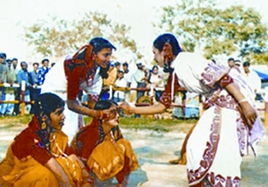
Golap-Tagar a team game, with an equal number of players on both sides, and played by both boys and girls. The chiefs of the teams are called 'kings'. The teams stand fifteen to twenty feet apart, separated by a boundary. At the start of the game, the king names his players after flowers or fruit.
Then the king blindfolds one of the players of the opposite team and calls one of the players of his team by their flower or fruit name, for example, 'Come, my Rose', or, 'Come, my Jasmine'. Then Jasmine or Rose goes over and flips the player on his forehead. The blindfold is then opened and the player has to guess who touched him on his forehead. If he succeeds, he jumps ahead, and if he fails, the opponent's player does so. The game continues till one team captures the land of the other. The opposing team members then lift the winning king across the boundary. In another variation of the game, the members of the losing team carry the winning players piggy-back across the boundary. The game is also known by other names such as baurani, chadankhela (Murshidabad), tukatuki (Mymensingh) etc.
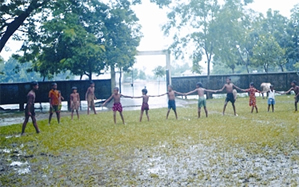
Gollachhut (touch and run) an outdoor game where a stick is planted in a small hole, thereafter called golla (circle) or the centre of the game. A tree or a stone twenty-five to thirty feet from the centre is fixed as the goal. The main objective of the game is for each player to take turns to run and touch the goal. In Bangla, chhut means 'to run', and hence the name gollachhut. The game is played between two teams of equal members, either five or seven.
The team leader in the game is called goda (chief). The chief circles round the stick in the centre holding it with one hand and holding a player with the other. The other players hold hands and also circle the stick with the chief. At some point, the last player in the chain frees himself and runs towards the goal and touches it. Players from the opposing team lie in wait at different points to touch the running player. If they succeed in touching him, he is considered out. The last to run is the chief himself. The teams play the game by turns. This game is mainly played in dhaka, faridpur, Madaripur, barisal and Khulna districts.

Gulikhela (game of marbles) Probably played in all countries, the game uses small glass balls or marbles as the playing objects. Marbles were first imported during the British regime. Previous to British rule, earthen balls were used in the game. In rural areas, boys play with earthen balls even these days.
Two or more boys play the game standing along a line nine to ten feet from a hole in the ground. The player whose turn it is takes everyone’s marbles and throws them towards the hole. He gets the marbles he is able to roll into the hole.He then tries to hit the other marbles one by one with his own marble.If he succeeds, he owns that marble as well. If he fails, or if he touches the other marbles, he has to give away one marble in punishment. He also loses his turn to the next player.

Ha-du-du (game of tag) This game, which now enjoys the status of the national game, is popular across the country. It is played by both children and adults, in two teams of about 10 players. A court is outlined on the ground measuring 20 feet x 30 feet. The teams station themselves on each side of the court.
When the game starts, one player, taking a deep breath and making a continuous sound, darts forward into the rival players' side and tries to touch as many players as he can without losing his breath. If he succeeds in getting back to his side, the players he has touched 'die'. The team that has touched most players wins.
Kadi khela (cowrie game) a game played by girls, singly or in teams. Four cowries of the same size are needed for this game. The player holds all four cowries in her hand and rolls them so that they fall close to each other but do not touch. She then taps one cowries to hit another. She does the same with the next pair. If she succeeds in hitting each cowries, she earns two points, otherwise she loses her round. If the cowries touch one another, the player loses her turn.
Additionally, if the cowries fall flat, the player earns one point. If they fall on their curved backs, each player hurries to pick up the cowries and kiss them to earn one point for each cowries. The player who first earns 20 points wins the game. This is the first phase of the game.In the second phase, the loser tries to guess whether the winner has an even or odd number of cowries in her hand. If the loser guesses right, she gets the cowries and if she guesses wrong, the winner earns points according to the number of cowries in her hand. The winner then hits the loser on her back with her fist according to the number of points she has earned.
Kanamachhi (literally, blind bee; blind man's buff) is played by both boys and girls. One player has a scarf tied round his or her eyes. The others move like 'bees' around the 'blind' player. The bees lightly strike the blind player, reciting the rhyme: kanamachhi bhon bhon, yake pabi take chon (Oh buzzing blind bee! Touch us if you can!). The blind player tries to catch or tag one of the bees, responding with the verse: Andha gondha bhai, amar dos nai (I'm blind, don't blame me if I bump against you). The player tagged by the 'blind' player plays the blind bee in the next round.
This game is also popular in Europe as 'blind-man's bluff'. In another variant of the game, known as lyangcha (the lame man), one player acts the 'lame man' and hops on one leg to catch others.
Lathikhela (club game) teaches self-defence with sticks. Until recently, the zamindars of Bangladesh employed a group of lathials (stalwarts wielding sticks) for security. In the char (shoal) lands, people still take possession of chars through stick fights. During muharram, lathials demonstrate their prowess and mettle in this game.

The sticks used for this game are four and a half to five feet long, and are often smeared with oil. Players manoeuvre their respective sticks around their body with stunning agility. Only sturdy youth take part in the game. In north Bengal, there is a similar game called chamdi, played at the time of Eid.Lukochuri (hide and seek) A team game, played by eight to ten players, with one of them playing the king. One player is chosen as the thief. The king covers the eyes of the thief with his hands while the other players hide themselves. After a while, the king frees the thief, who tries to find the players, while the players try to touch the king without being touched by the thief. A player who is touched by the thief becomes the thief in the next round. It is also known as palapali (hiding) in the regions of Jessore, madaripur etc. In some areas, the game is customarily played by newly-married couples on their wedding night.
Mogalpathan (draughts) also known as solaghunti, is a checkers-like game, with sixteen pieces on each side. The game is played with two additional triangular courts at both ends of the baghbandi court. The players place their pieces in the squares and move their pieces forward one position at a time. If a piece jumps over his opponent's piece to the next vacant position, the opponent's piece dies and is removed from the game. The one who kills the opponent's pieces first wins the game.
Nunta (count till seven) In this team game, one player becomes the owner of a large circle outlined on the ground. At the start of the game, everybody remains inside the circle excepting the owner, who remains outside. The owner goes round the circle reciting nunta, a rhymed formula. When he finishes reciting the rhyme once, the players inside cry out 'one'. When the owner finishes reciting the rhyme for the seventh time, the players inside rush out of the circle and the owner takes possession of the circle.
Nunta is also known as kutkute khela in the Jessore and khulna regions. In that variation, the owner cries out kutare while others count ekre, duire, tinre etc.
Openti Bioscope is mainly played by girls. Two players face each other and touch their arms to form an arch. The other girls pass under the arch in a circular path reciting a rhyme until they come to the last line: amar nam Jadumani, yete habe anekkhani (My name is Jadumani, I have to go a long way). When the last line is uttered, both the girls bring down their arms on the girl passing under the arch at that moment. All the others then rejoice, holding the girl aloft.
Putul Khela Playing with putul or dolls is universal. Apart from treating dolls as little babies to be fed and put to sleep, girls learn social rites and rituals through playing with dolls. A favourite game in Bengal, as in other parts of India, involves doll weddings. Putuler Biye (The Doll's Marriage) by kazi nazrul islam is a short play which describes a doll wedding.
Rajar Kotal (king’s constable) a team game played by both boys and girls. The players sit in a circle, holding hands. One player, the king’s constable, stays outside the circle. The game begins with him going round the players, reciting the rhyme: kantar pichhe ke ghure? rajar kotal/ kiser janye? ek chhadi kalar janye/ kal ye niya gechhila? ghoday mute diyachhe/ dhuya dhuya khao ni? chhi! hak! thu!! tabe ek chhadi niya yao (Who’s behind me? The king’s constable.
What for? For a cluster of bananas. Did you not take one yesterday? Horses pissed on them. Eat them after washing. Wack! Wack! Then take a cluster from here). The constable then pretends to cut down a cluster of bananas and takes away one of the players. The constable begins circling them again, chanting the same rhyme. The game continues till the constable takes away all the players.
Rumalchuri (stealing the handkerchief) mainly played by young children. One child plays the part of the thief. The others sit in a circle. The child playing the part of the thief goes round the players and quietly leaves a handkerchief at the back of someone.If the player behind whom the thief has left the handkerchief senses what is happening, he/she springs up and exchanges places with the thief.
Otherwise the thief continues to go round till he/she reaches the player with the handkerchief. The thief then thumps the player on his/her back. The player then has to play the part of the thief. The game is known as mudakhela in Kishohreganj.
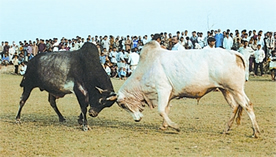
Satchada (seven tiles) a team game with an equal number of players on both sides, played with seven potsherds or flat stones. The stones are placed one on another. A player of one team stands ten to twelve feet away and tries to dismantle the tower of stones by throwing a rubber or tennis ball towards it. The players of the other team try to set it up again while the player who had thrown the ball now tries to hit them with the ball. If she succeeds in hitting a player, the player is out.
Satkhola (dice in seven holes) is a game of two players. Two rows of seven small holes are made in the ground and seven tamarind stones are placed in each hole. One of the players starts the game by moving his stones. He picks up the stones from one of his holes and then drops them one by one into the successive holes. When he finishes distributing the stones, he takes up all the stones from the next hole and does the same again.
If the last stone from the hole falls into one of the player's empty holes, he takes possession of all the stones of the following holes. But if two holes are empty after the hole where the last stone falls, then he loses his round. The opponent plays in the same way.
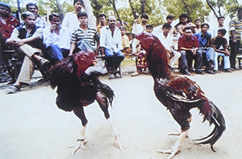
Soljhapta (kissing the stick) a game from Murshidabad, is played by cowherds in mango or litchi orchards. A toss decides the thief, who places a stick on the ground and stands touching one side of it. Other players station themselves in nearby trees. The thief then tries to touch one of them and rushes back to the stick to kiss it. If he succeeds, the player he has touched becomes the thief in the next round. Bull fight
The game is also known as gachhchhuya gachhchhuya in Mymensingh and dagare daga in Vikrampur. In the gachchuya gachchuya variation, a tree takes the place of the stick in the game. One of the rhymes recited in this game is about sylvan life: gachhgchuya re gachhchhuya/ gachh kyare? bagher dare. bagh kai? matir tale/ mati kai? ei to/ tora kay bhai? sat bhai/ ek bhai dibe? chhuinte parle nibe (Tree-climber, tree-climber, why are you up in the trees? For fear of the tiger. Where's the tiger? On the ground. Where's the ground? Here it is. How many brothers are you? Seven brothers. Will you give me one? Take me away, if you can).
Games in water Apart from swimming and boat-racing, water games include catching and tagging games.

Boat-race an ancient and traditional folk game, often played competitively on the occasion of fairs and pujas. As the young men ply their oars, musicians beat drums and play other percussion instruments to encourage the punters. The boats used in race do not have masts or sails. The agility and strength of the punters and the helmsman are the deciding factors in the game.
Holdug (tag me in water) played by boys while bathing in rivers or ponds. The boy who wins the toss takes some water in his hand and asks questions which others answer: eta ki? dudh/ eta ki? tyal/ eta ki? marich/ bap bale dharis (What's this? Milk. What's this?/ Chilli. Catch it if you can). As soon as he finishes the formulaic rhyme, he dives and others try to find him. The one who touches him first becomes entitled to question the others in the next round. The game is played by turns. This game is known as malai in Mymensingh and hattihatti in noakhali.
Jhappuri khela a group game played by boys. The players stand in waist-deep water in a pond, forming a circle. One of them holds a fruit that floats on water. He throws the fruit up and everybody rushes to catch it. The game is also known as tai tai khela in some regions.
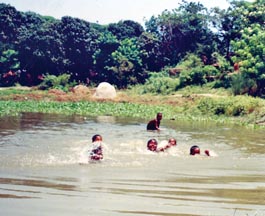
Lai khela (find me out) a group game played by boys. The word lai is derived from nabhi, the Bangla word for 'navel'. A boy, standing in chest-deep water, asks, amar hate ki? jalai ek dube talai/ tore yadi pai/ ek gerase khai (What's in my hand? Nothing but water. Under the water in a dive. If I can catch you, I’ll eat you in a swallow). He dives saying this and the other players try to find him. If he can avoid being touched, he earns a point. If he loses, the one who catches him begins the next round. panijhuppa (skimming the pebbles) In this game, boys or girls try to skim pebbles or potsherds over the surface of the water. The player who skims the pebble farthest is the winner. The game is also known as kholamkuchi khela (game of potsherd) in some regions.
Flying Games Popular games include flying kites and pigeons. Flying Kites is popular in Bengal as in other parts of South Asia. As soon as the weather turns dry and windy, boys start flying kites. Both children and adults participate in kite-flying competitions, during which the participants try to cut the strings of other kites. Accordingly, the kite strings are coated with glue and powdered glass so that they can easily cut the strings of their rivals.
Flying pigeons Though there are varieties of pigeons, only girobaj pigeons are used for flying. There is also a game of hunting pigeons with pigeons. [Wakil Ahmed]
Bibliography A Saha, Banglar Laukik Kridar Samajik Utsa (Social Origins of the Folk Games of Bengal), Pustak Bipani, Kolkata, 1991.
